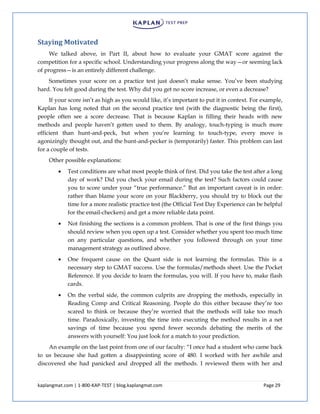The document provides an overview of GMAT scoring, including:
1) The total score ranges from 200 to 800 and is the primary score considered by business schools, with most students scoring around 550 and top programs requiring over 718.
2) Section scores range from 11 to 51 on the quantitative and verbal scales, though percentiles are a also considered.
3) The AWA is scored separately on a scale of 0 to 6, with a 4 considered satisfactory.
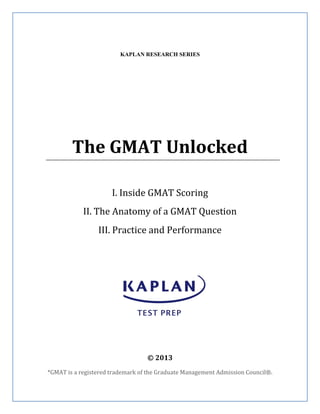

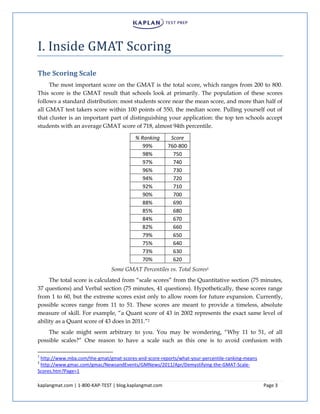


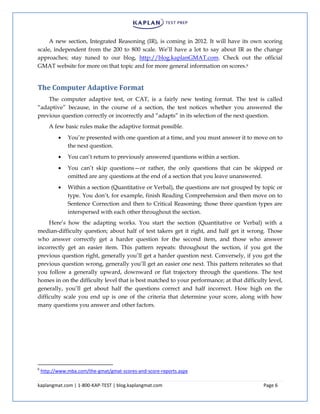
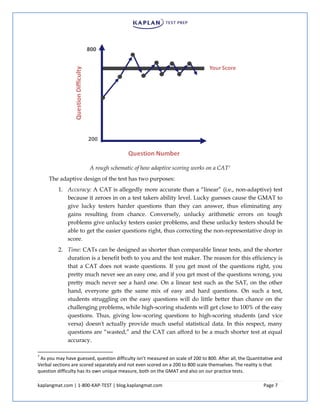

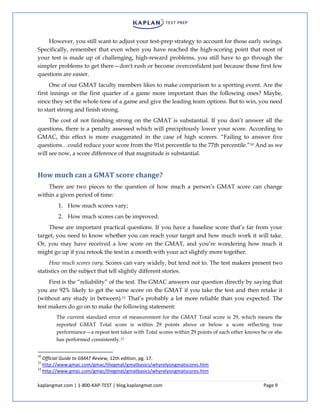







![kaplangmat.com | 1-800-KAP-TEST | blog.kaplangmat.com Page 17
Sentence Correction is the Verbal section for which you’ll most likely have to brush up.
While the Official Guide is rather brief in summarizing the math content you’ll need to know for
the Quant section, it’s silent on such content for Sentence Correction. For this reason, applicants
often get caught up studying grammar and rhetoric patterns that rarely appear on the test, if
ever, such as homonym errors (e.g., “effect” vs. “affect”) and the proper use of first- and
second-person pronouns (e.g., “if there’s a problem, please tell Rob or I [sic].”). The winning
strategy is to brush up on the specific grammar patterns that the GMAT tests, focus on clear and
precise communication, and work through a large number of realistic practice questions.
For further study of content, here are a few resources:
Our 100 Hours GMAT Study Plan is an Excel schedule accompanied by a recorded
session describing how to approach the study process. It’s available for free at
http://www.kaplanGMAT.com/blueprint.
The Official Guide (http://amzn.to/GMATOG), published by the test makers,
contains extremely brief, but information-rich, summaries of what is included on
the test. Specifically, the “Math Review”15 in that book clarifies that you may see
trapezoids or complex polygons on the test (because they are in the Math Review);
that you may see combination and permutation questions (because they are in the
Math Review); but that you will not see trigonometry (because it’s not in the Math
Review). The Official Guide is included and incorporated into our GMAT program.
Our courses and self-study aids cover everything tested on the GMAT. Good places
to start are the GMAT Premier (http://amzn.to/GMATPremier) publication or the
GMAT Advantage On Demand (http://bit.ly/GMATOnDemand) course for self-
studiers—or our GMAT Advantage course (http://bit.ly/GMATAdvantage), which
is offered On Site and in our Classroom Anywhere environment.
A final note on the test’s content: the test makers are explicit that the GMAT algorithm
includes measures to balance the content you see. As the Official Guide puts it, “the test selects a
specific number of questions of each type,” such as arithmetic.16 There are a few practical
implications here, and a couple of caveats worth noting. The implication is that you want to
take a balanced approach to practicing GMAT question types. More specifically, you’ll want to
plug the holes in your preparation and focus on weak spots you are sure you’ll be tested on.
Note, however, that some question types and topics, such as permutations questions, are
inherently more difficult. If you’re scoring at, say, a 550 level, you won’t see these questions and
you want to prioritize your study of the more prominent topics first. Another caveat is that test
takers’ anecdotal reports of content balancing on the test vary widely. Don’t be thrown off on
test day if you see more or fewer of a particular topic than you expected.
15
Official Guide to GMAT Review, 12th edition, pg. 106.
16
Official Guide to GMAT Review, 12th edition, pg. 8.](https://image.slidesharecdn.com/9yad71r0qfcjylubevyr-signature-6d95a539d02c9c92cc8a1ed14f39672b4db14b0c69de10da031e42a0db002995-poli-150310153403-conversion-gate01/85/The-gmat-unlocked-17-320.jpg)











